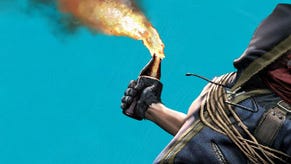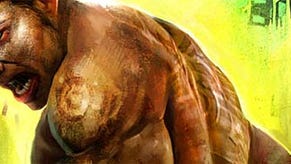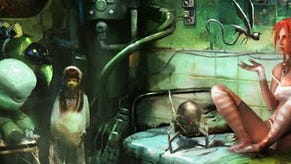Can to can't - The story of Enslaved: Odyssey to the West
They say it's the journey that matters, not the destination. We follow Enslaved: Odyssey to the West from Ninja Theory's concept through to the recent shelving of sequel plans.
On the back of a successful new IP, Heavenly Sword, Ninja Theory was living the developer dream - it had the chance to win backing for a passion project. That passion shows through in every aspect of Enslaved: Odyssey to the West's production.
It's a game everyone expected to succeed. It combines jaw-dropping graphical prowess with a satisfyingly tactical AI-buddy combat system, features stellar character performances and lush cinematics, and lets you play as a bad-ass who almost has a tail. While its strangely-concluded sci-fi narrative didn't please everyone, it defied medium convention to depict a genuinely moving non-romantic relationship.
When the game also defied expectation and lingered on store shelves unduly long, both Ninja Theory and Namco Bandai gently dismissed franchise hopes and moved on. We look back on the game's path from can to can't.
Where did I come from?
Having been responsible for early PlayStation 3 breakout Heavenly Sword, Ninja Theory could have been forgiven for taking the sequel track, but although Heavenly Sword 2 is probably never going to happen, Enslaved is, in some ways, a product of Heavenly Sword's success.
"We felt it had been really interesting having the main character Nariko accompanied by a sidekick called Kai," chief technical director Mike Ball said.
"We had received a lot of good feedback about the relationship between the two characters and it was nice to have some gameplay unique to both of them."
Creative director Tameem Antoniades latched onto the buddy-system of differing but strategically combinatory gameplay, although the team was initially reluctant.
"On the face of it, it naturally felt like an escort mission and let's face it, escort missions are difficult to love," Ball said.
Perhaps what was needed was a strongly identifiable core relationship, something more than the two-oddball-partners cop show theme.
"Ultimately that inspiration came from the original story of Monkey in Journey to the West, a 400 year-old Chinese novel which had spawned a TV series that was really popular in the UK when we were kids," Ball said, noting that the game idea "snowballed" from there.
Monkey, or Monkey Magic, a cult-favourite BBC dub of a 1970's Japanese serial, was particularly notable for its casting of the delicately beautiful Masako Natsume as the monk Tripitaka, gender swap being a traditional method of expressing spiritual beauty among male religious figures. The strangely antagonistic but increasingly devoted relationship between Triptaka and the captured Monkey, played by comedian Masaaki Sakai, influenced a generation of viewers.
With this iconic and compelling dynamic as the heart, Ninja Theory had its work cut out to create a unique and distinct aesthetic while still invoking the source material.
The intensely colourful post-apocalypse of the finished game seems cut from whole cloth, a natural and appealing setting in which players familiar with Monkey are constantly delighted by both the gentle nods to the myth and Ninja Theory's departures. But getting there wasn't easy, involving a period of wild experimentation and design dead-ends.
"At one point, Monkey was completely white haired based upon a picture of an albino gorilla that Alex Taini, our art director had found," Ball remembered.
Pitching it thick
Once it had a solid concept under its belt, it was time for Ninja Theory to take Enslaved on the road - with cinematic pitch in tow.
"When we create a new IP we actively take it to a number of publishers to find the right fit for that product, and the cinematic is a fundamental of that pitching process," Ball said, explaining the developer's decision to go "bigger and better" with Enslaved than ever before.
"We spent months creating the cinematic whilst also working on a very detailed design document," he continued.
"We took the pitch on a tour of publishers in the States and in just a couple of weeks we had garnered a lot of interest. When we showed it to Namco Bandai, they understood it straight away and so a deal followed quickly."
Oliver Comte, Namco Bandai Partners' senior VP of marketing, sales and publishing, said Enslaved had "all the right ingredients" to win the publisher over.
"Essentially when you greenlight a product it's always because you feel strongly about the concept, the studio and the people. Enslaved is a perfect example of this," he said.
Comte said Namco Bandai doesn't have a dedicated budget but does set a target number for externally developed games, in order to round out its offering.
"We look for things that are different to what we already have so we end up with a portfolio that's as complete as possible," he said.
It was love at first sight, apparently, and while Namco Bandai took a close interest in the game's progress, it also took steps to try and relinquish control.
"The publisher is paying and so naturally wants to be involved in making key decisions. On the other hand, the developer feels, and rightly so, that the game is their baby and they know it better than anyone," Comte said.
"The relationship that we had with Ninja Theory was excellent, and the quality of the game is the proof. It's impossible to release a big game unless everyone's pulling in the same direction."
World Building
With funding secured, Ninja Theory could get on with fleshing out the world of Enslaved. It reached out once more to one of its key creative partners: Andy Serkis, the veteran voice and motion capture artist whose iconic performance as The Lord of the Rings' Gollum made him a geek culture byword.
"We built a great relationship with Andy whilst we were working on Heavenly Sword. It was such a good experience that it was only natural that we teamed up with Andy again and as soon as we had a concept for the character we showed it to him," Ball reminisced.
"I just can't imagine anyone else playing Monkey."
Ninja Theory runs its motion capture sessions in a similar fashion to Naughty Dog's work with Uncharted, explaining why both developers have drawn massive critical acclaim for their realistic animation and character performances.
"We treat the whole process like a stage play," Ball explained.
"The actors have a few days prior to the shoot to get to know each other and to explore the characters that they are going to be playing. This process really helps to shape the performance and allows the actors to add a little of themselves to the characters also.
"When we get the footage back from the shoot, I'm convinced that the performance totally changes the whole team's expectations of the characters.
"Some new stuff gets created ad hoc on the performance stage too, so all in all, it actually allows us to go back into some of the levels and add more to the gameplay based on the performance."
Monkey, Trip, and Pigsy share star billing with another major character: the lush and beautifully colourful environments, which Ball said were a reaction against the blobbity-blob grey mud of modern game design.
"Just say 'no' to boring, drab game levels."
"That's one of the things that we are really proud of. Just say 'no' to boring, drab game levels," Ball commented.
"It's also the case that Alex's favourite colour is red, so you'll notice a lot of red in the levels."
Highlighting the ruinous metropolis which was once New York as a favourite, Ball said the team were inspired by The History Channel's Life After People documentary series, but also sacrificed realism when it suited the flow of player experience.
"There was a constant argument in the design team about whether or not it would be acceptable or not to play with the metrics of the city and move some of the landmarks to make it work from a gameplay point of view," Ball said.
"I've never seen any complaints about the liberties that we took so I guess we got away with it."
Nevertheless, there are a number of small details of Ninja Theory's design which did not go unnoticed.
"There's one really simple element of the game that a lot of people love and that is a tiny robot with a big eye in one of the junkyards. As you walk by, it turns to follow you – a little piece of life left in the barren world. Really, really simple to implement but everyone loved it," the developer said.
"There's also a big robot hand in a later level that is a reference to Buddha's fingers in the original Journey to the West book that inspired us."
Expectations unmet
Enslaved launched in early October 2010, within weeks of Civilization V, FIFA 11, Medal of Honor, Fallout: New Vegas and Rock Band 3 - among others - and just ahead of the end of year release flood. It managed a respectable Metacritic in the low 80s, but more importantly than the numbers attached to those reviews was the acknowledgement that, despite its flaws, it was one of the most important games of the years.
But consumers were not so kind. By February, Enslaved had failed to crack 500,000 sales, and at the of Namco Bandai's financial year, had managed just 750,000.
While the game isn't a failure - Namco Bandai has said longer term sales are good - its relatively lacklustre performance means Ninja Theory has had to put aside its hopes of developing the franchise, and can plans to spin off a second team for now.
Namco Bandai put the under-performance down to timing, blaming the holiday season and expressing satisfaction with its quality and review scores.
There's another likely culprit, though - Enslaved's opening sequences fail it, refusing to communicate the depth of gameplay to be expected in later levels. This opening was delivered as a demo as well as the hands-on build shown at events, presenting what appeared frighteningly like a button-mashing brawler with some set-piece platforming. In an era when metrics demonstrate just how infrequently gamers push to the end of single-player campaigns, Enslaved had little chance to build word of mouth buzz.
"We spent a long time building up to the more strategic combat and looking back, that was a mistake."
"We never wanted to be seen as a competitor to God of War and the like, so we had derived a concept of strategic combat. In our minds we wanted the player to evaluate a combat scenario ahead of them, make plans about how Monkey and Trip were going to work together to get through the combat and then launch into executing their plan," Ball said of Ninja Theory's intentions.
"It's difficult to get the balance of abilities versus progression. I guess in our case we spent a long time building up to the point where you could really explore the more strategic nature of the combat and looking back, that was a mistake."
Please sir, more?
"We would love to do a sequel to the game," Ball said, echoing a sentiment strongly voiced by Enslaved fans.
"We had made a beautiful and vibrant, if totally ravaged, world that would be great to spend some time in again.
"The whole journey to the west was a metaphor not only for the physical journey that Trip and Monkey make from the east coast of America to the west, but the characters in the game followed their own journey that saw their relationships and characters evolve over time.
"There's not only the world to continue exploring but the characters as well. There are lots of ideas and possibilities."
But making a loss on one beloved game is one thing, and funding a whole series is another. In his business role, Comte must, of course, be cagey on the subject.
"You always end up having the same discussion between the head and the heart."
"There are lots of factors to take into account, such as the publisher's portfolio, the success of the first one, the studio's capacity, the timing and, of course, the investment. Making games is a complicated business.
"All these ingredients need to come together at the same time, which doesn't always happen," he said, before throwing a slender bone of hope.
"You always end up having the same discussion between the head and the heart. Personally I would be sad if Enslaved stopped here, and I'm certainly not alone in wanting to see the next episode in the adventure, so we'll just have to see what happens."











